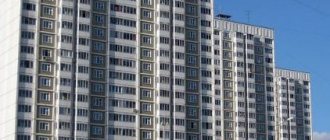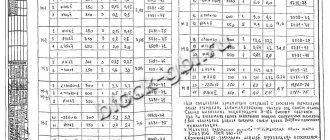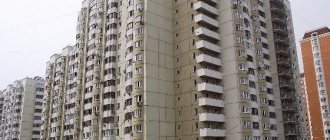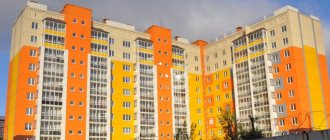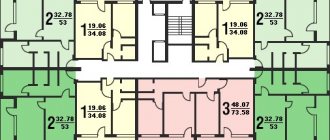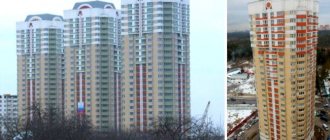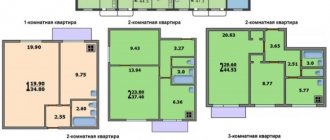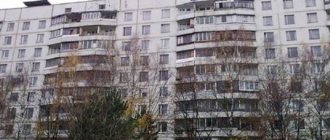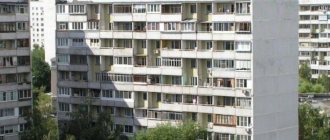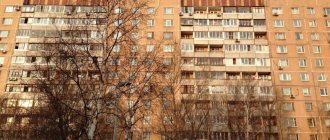Houses of series II-14 are Khrushchev buildings, which were put into operation from 1957 to 1964, until it was decided to increase the number of houses being built from panels and large-block houses. Construction took place in Moscow and Moscow Region; houses in this series can be seen in Reutov, Lyubertsy, Kotelniki, Khimki, Lytkarino, Dzerzhinsky. In total, about 550 houses were erected, and the neighborhoods were not built with them. Usually they were limited to 2-3 buildings per microdistrict.
Distinctive external features by which series II-14 houses are usually recognized:
- walls made of red and gray-red brick, without cladding;
- the presence of protruding balconies on the facade;
- 2 rows of windows at the end;
- windows with 4 sashes;
- the shape of the building is a simple rectangle;
- no corners or protruding parts.
Buildings of this type are not in danger of being demolished, however, in the area of Magistralnye Streets, buildings are being rehabilitated, and in Lytkarino, some houses are in the reconstruction project area.
Years of Khrushchev's brick buildings
Houses are a type of building with one-, two- and three-room dwellings, the height of which was 2-5 floors. Such buildings were erected at a time when N.S. Khrushchev was at the head of the country. In the period from 1957 to 1985, their construction was carried out in different regions of the country.
Various types of such houses were erected. They could be demolished - the lifespan of five-story Khrushchev-era buildings was planned for them to be 25 years. They also designed unbearable Khrushchev buildings. They were supposed to last 50 years, but after a series of experiments it was decided that with regular repair work, their service life could be tripled.
In some cities, houses are insulated from the outside during restoration work.
Brick Khrushchev series of houses
Multi-storey brick buildings were built according to more than one model. Groups of projects were developed that determined the characteristics of the houses on which they were erected. The most common were:
- I-528.
- I-447
- I-511.
- II-14.
- II-34.
- I-513.
- II-20.
- Mm1-3.
Brick houses of the I-528 series are considered the highest quality of buildings. The height of the ceilings in a brick Khrushchev building is up to 2.7 m. Brick is used for the external walls. High quality parquet was laid on the floors, the doors were paneled, and the window frames were well fitted.
Layout of a 1-room apartment in Khrushchev I-528 series on the ground floor, corner location
Layout of a one-room Khrushchev I-528 series with a balcony at a standard level, corner location
Layout of a two-room apartment in Khrushchev I-528 series on the first level, central location
Layout of a 2-room Khrushchev apartment with a balcony at a standard level, central location I-528 series
Layout of a 2-room apartment with a balcony on a standard floor
Layout of Khrushchev 2 rooms I-528 series 1st floor
Khrushchev 2-room apartment layout with bay window I-528 series
Most of the buildings were erected no higher than 5-6 levels. The projects did not include such utility elements as an elevator, an attic and a garbage chute.
For development, places were chosen near good transport links, with developed infrastructure; the cost of housing was low.
Disadvantages of houses
One of the rather significant disadvantages of type II-14 houses is the lack of a garbage chute. Elevators are only available in buildings with 6 floors. Even today, 50 years later, many houses do not have a centralized wire, so they have to use gas water heaters. There is no fireproof balcony.
The small total area of the apartments somewhat limits the owners in redevelopment, however, “Star-Service” will in any case help you arrange a standard redevelopment of houses of the II-14 series.
Characteristics of brick buildings from the time of Khrushchev
Residential buildings made of brick, called Khrushchevkas, were built mainly 4-5 floors high, some had 9. The buildings housed small-sized living quarters with small rooms, which were included in the projects as passageways.
When developing houses, we tried to reduce the costs of their construction as much as possible. Architectural excesses, stucco elements, and external decorative finishing were excluded. Tile and slate roofs were replaced with flat bitumen ones.
The height of the walls in Khrushchev was 2.48 - 2.7 m. Bathrooms in such houses were of a combined type. There were no garbage chutes in the building.
Thermal insulation and soundproofing
Sound insulation of the internal walls was provided, but it was insignificant. Many of the residents noted good audibility in the brick Khrushchev from neighboring rooms and even apartments. Having received living space, some of the new residents tried to install soundproofing layers on their own. This helped to correct the situation a little, but due to the presence of ventilation ducts, audibility still remained.
Residents of such houses noted that it is very cold in a brick Khrushchev building. But the situation with thermal insulation in houses built from panels or blocks was worse.
Building height
The buildings had different number of storeys. It was determined by its location. In small settlements, houses could have 2-3 floors. In large cities - 4, 5 and even 9 floors.
A simple formula was used to calculate the height of the house. The overlap was added to the distance from floor to ceiling and multiplied by the number of floors. If a series of houses had ceilings with a height of 2.4 m, then for three-story buildings the height was about 9 m. In five-story buildings it was 15 m. They could have more living space, so such buildings gradually replaced four-story houses. According to building codes, an elevator is not required in buildings below the 6th floor, which further reduced costs.
Typical room sizes
In such buildings, the approximate area of a one-room dwelling was 30 square meters. m, two-room apartments - 43 sq. m, three-room apartments - 60 sq. m. m.
Kitchens in all projects are small, 5-6 square meters. m. Other premises have the following area:
- Living rooms - from 14 sq. m.
- Bedrooms - from 8 sq. m.
- Children - from 6 sq.m. m.
It is extremely rare for multi-storey buildings to include four-room housing in the design.
Housing layout
In the first houses of this type of construction, passage rooms were included when drawing up projects. This was inconvenient for residents, but was corrected by careful interior planning. The living area was small.
The layout options for two-room apartments were as follows:
- The “book” is a passage room with a wide entrance opening, from which a door leads to a smaller room.
- “Tram” - living rooms are located one after another.
- “Vest” - the hallway and kitchen are placed between the rooms.
Such options for the location of premises were the most common. The rooms are mostly adjacent, with windows facing one side of the house. The presence of a storage room and a balcony is an additional advantage.
Other characteristics
The living space in a brick house is convenient for redevelopment. There is no shrinkage, the foundation is reinforced, the likelihood of distortions is minimal. Installing a ventilation duct inside the walls is convenient for everyday life. There are no boxes spoiling the interior; There is also less chance of mold and dampness forming. The living space is comfortable, environmentally friendly, and breathing in brick houses is much better than in panel houses. This helps create favorable conditions for people living in apartments.
In the summer, brick walls do not heat up, which ensures that the temperature remains comfortable for living. Many houses have loggias or balconies. Such elements provide additional space, which is convenient to use for household needs.
In terms of housing, the layout provides useful elements that are convenient for family people. For example, a special niche under the window in the kitchen in a Khrushchev-era building, intended for use as a pantry. You can store out-of-season items in it without cluttering up your living space. The thickness of the outer wall in this place is equal to half a brick. It turns out to be an additional refrigerator under the window.
Ordinary Stalinka: types and series
What should a person who decides to buy a Stalinist know about? What are its features, pros and cons? We examine in detail the housing of the period of Stalinist housing construction and continue the detailed analysis with a story about ordinary houses.
“Moving to a new apartment”, A.I. Laktionov (1952)
Houses built in the USSR are usually named after the name of the leader under whom these houses were erected: Stalinist, Brezhnevka, Khrushchevka. And the Stalin buildings in this series are the most interesting from an architectural point of view. This period covers more than twenty years: then urban planning plans were adopted that determined the appearance of many cities in the post-Soviet space. Stalinka buildings are recognizable buildings of an individual or small-scale project, and this is how they fundamentally differ from the faceless large-scale Brezhnevka buildings and, in particular, the Khrushchevka buildings. It is interesting that both the beginning and the end of the Stalinist period in the architecture of the USSR were associated not with natural development or some emerging trend in architecture, but with the strong-willed decision of the country's leadership. The beginning of the Stalinist period in art, including in architecture, was marked by the actual prohibition of constructivism, and the end was marked by the 1955 Decree of the CPSU Central Committee “On the elimination of excesses in design and construction.” Then the course was set for the construction of cheap mass housing, and Stalinist buildings became living history.
Residential Stalin buildings can be divided into several types: elite housing for the nomenklatura, which we talked about last time, ordinary Stalin buildings and low-rise cheap housing. We will analyze the last two types of Stalins today.
Ordinary Stalinka of improved quality
Serial Stalin buildings, as a rule, are significantly inferior in quality to luxury houses, which, as you know, were built according to individual projects (you can read about the advantages and disadvantages of both here). But some improved series occupy an intermediate position between the elite and the ordinary.
For example, these are 8-10-story brick buildings of the SM-6 series,
of which only about 130 houses were built. The main location is on Leninsky, Lomonosovsky, Universitetsky and Nakhimovsky prospects, in the Sokol, Airport, etc. First of all, the series, which is considered moderately elite (such an interesting definition) due to its successful location in prestigious areas, is well recognizable by sand-colored brick walls and bay windows. Some of the houses were used to serve the diplomatic corps at the Russian Foreign Ministry, but they won’t choose anything bad. The total area of a two-room apartment here is 44-60 m², a three-room apartment is 67-84 m², and a four-room apartment is 92-103 m². The kitchen is from 7.5 to 10.5 m², and these sizes give even some nomenklatura houses a head start. But the ceiling height is completely “non-Stalinist” - some 2.7 m.
House series SM-6
Series II-02
It is also represented by brick houses, but already lined with red tiles. From 1952 to 1958, about 20 such houses were built in Moscow on the street. Stroiteley, st. Kuusinen and st. B. Galushkina. There are only a few entrances in each house - three, the number of storeys is still impressive - 7 or 8, and the ceiling height of 2.9 still speaks of Stalin’s scale. The areas of the apartments here are as follows: one-room - about 45 m² (25 of them are living space), two-room - 69 m² (living - about 45 m²), four-room - about 100 sq.m. (living – 64 sq.m.). Kitchen area starts from 10 m².
House in the center - series II-02
Number of storeys of brick houses series II-08
the same as its architectural “predecessor” - 7 or 8. In the period from 1957 to 1962, about 45 houses were built on Kutuzovsky and Leninsky Prospekts, on Presnya, in Fili and in some other areas. There is a passenger elevator, but there is no garbage chute, which has become a kind of sign of the Stalin era. The total area of a one-room apartment in the house is 34 m² (living – 18 m²), two-room – 56-62 m² (living – 35-40 m²), three-room – 68-80 m² (living – 46-51 m²). The kitchen in a one-room apartment occupies 7 m², in a two-room apartment and a three-room apartment - 8.5-13 m².
Series II-04
– this is the first standard post-war block series, fundamentally new at the time of development. Over six years - from 1954 to 1960 - about 45 houses with a height of 6-8 floors were built on Khoroshevskoye Shosse, Khamovnichesky Val, Lyublinskaya Street and in the areas of the VDNH and University metro stations. There is no elevator or garbage chute here, but the ceiling height is 3 meters, and the rooms are isolated. The external walls are slag concrete blocks 50 cm thick, the thickness of the gypsum concrete partitions is 15 cm, and the floors are made of reinforced concrete slabs - 22 cm. The total area of a two-room apartment is 54 m² (living area - 33 m²), a three-room apartment - 78 m² (living area - 52- 53 m²). The kitchen area in II-04 is from 8 to 10 m².
Ordinary Stalinists
Most of the ordinary Stalin buildings are represented by ordinary brick five-story buildings, the only difference is which brick was used as a building brick. Pre-war buildings were built mainly from red brick, while post-war ones were built from silicate brick (often they were not plastered). The apartments in these houses were communal - for those who were not lucky enough to become a nomenklatura worker, but sometimes the housing in them was used as separate apartments. Such houses were used to build working-class neighborhoods near enterprises and city outskirts, so the decor of the facades here is, to put it mildly, minimal and not at all similar to what the elegant Stalinist buildings of the beginning of this architectural period are famous for. The ceilings in the houses are usually three meters high, the rooms are quite large. Internal partitions are often made of wood and covered with plaster over shingles; of course, there is no elevator or garbage chute. What can I say - sometimes even hot water was not provided here and there was no bathtub as a feature. Ordinary late-built Stalin buildings were also built from cinder blocks. Their quality, of course, is lower than that of brick ones, and the layout is poorer.
Ordinary Stalin buildings include houses of several series.
Exclusively Moscow series II-01, II-03 and II-14
are represented by late Stalinist brick five-story buildings (built in 1952-1964).
In total, the following were built in the capital: about 70 houses of series II-01
(districts Presnya, Izmailovo, Sokolniki, Tekstilshchiki, Koptevo, Rogozhskaya Zastava, Butyrsky Khutor), 180 houses of series
II-03
(in almost all areas being built at that time - Airport, Sokol, Lefortovo , Izmailovo, Sokolniki, Oktyabrskoe Pole, Nagatino, Tekstilshchiki, Savelovsky, Kozhukhovo, Kuntsevo, etc.) and a record for Stalin-era 550 houses of series
II-14
(in various districts of Moscow).
The characteristics of the houses of these series are as follows: the number of floors is from 3 to 6, the mandatory presence of a gas stove, separate bathrooms, the absence of a garbage chute and an elevator, in the early houses of the series there are gas water heaters. The external walls are made of bricks 50 cm thick, the internal ones - 40 cm. The thickness of the gypsum concrete partitions is 15 cm, and the thickness of the floors made of reinforced concrete slabs is 22 cm.
House series II-14
For houses series II-01
the total area of a three-room apartment is 75-78 m², a four-room apartment is about 100 m², the rooms are isolated, the kitchen is from 8 to 11 m², the ceiling height is about 3 meters.
The total area of the houses of series II-03
is somewhat smaller: the footage of a two-room apartment is about 50 m², a three-room apartment is 66-76 m², and a four-room apartment is 85-91 m².
The kitchens here are also more modest, as are the ceiling heights: 7.5-9 m² and - 2.7 m, respectively. The total area of the houses of series II-14
is no worse, and in some ways even better than their “predecessors”: a one-room apartment is 34 m², a two-room apartment is 43-55 m², a three-room apartment is 71 m² (kitchen - from 7.5 to 8 .5 m²).
The MG-1 series belongs to the same class
- a compact four-story brick house, square in cross-section. In total, in 1955-60, approximately 80 such houses were built in different areas of Moscow and the region. The total area of a one-room apartment is 33-38 m², a two-room apartment is 56-59 m², a three-room apartment is 77-79 m² (kitchen - from 8 to 10.5 m²). Ceiling height is 3 meters.
Low-rise housing
Mostly low-rise housing is represented by two-story brick, sometimes cinder block houses with no more than two dozen apartments. People called them “German” because they were often built by captured Germans - after the war and until the transition to block and panel construction in the late 50s. Externally, the low-rise housing is little remarkable: the facades were plastered and decorated with simple stucco decoration. Such houses had a multi-slope complex roof, wooden floors and no basement. Sometimes they lack even the most necessary communications: central heating, water and sewerage. They could also be made in two versions - with central heating and with a stove, when connecting to a thermal power plant was impossible.
Low-rise housing was usually built on the outskirts and in small towns - not point by point, but quarterly, like the Khrushchev panel later, but not on such a scale. And the quality of this kind of houses is often even worse than Khrushchev-era buildings.
Alisa Orlova
Illustrations: Anastasia Timofeeva
14.06.2016
